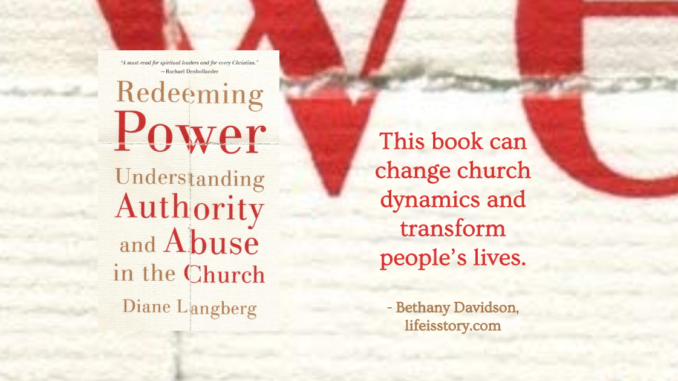
Also by this author: Redeeming Power: Understanding Authority and Abuse in the Church
Published by Brazos Press on October 20, 2020
Genres: Non-Fiction, Christian Life, Theology
Buy on Amazon
Goodreads

Power has a God-given role in human relationships and institutions, but it can lead to abuse when used in unhealthy ways. Speaking into current #metoo and #churchtoo conversations, this book shows that the body of Christ desperately needs to understand the forms power takes, how it is abused, and how to respond to abuses of power.
Although many Christians want to prevent abuse in their churches and organizations, they lack a deep and clear-eyed understanding of how power actually works. Internationally recognized psychologist Diane Langberg offers a clinical and theological framework for understanding how power operates, the effects of the abuse of power, and how power can be redeemed and restored to its proper God-given place in relationships and institutions. This book not only helps Christian leaders identify and resist abusive systems but also shows how they can use power to protect the vulnerable in their midst.
Diane Langberg is a psychologist with decades of counseling experience. In her latest book, Redeeming Power: Understanding Authority and Abuse in the Church, she presents a strong call for Christians to reevaluate their understanding of power. She writes about power dynamics that many pastoral leaders and parishioners are oblivious to, showing how even well-meaning leaders can end up in unhealthy situations. She also indicts those who use their power to deceive and destroy others, and shares stories from her counseling experiences to show how frequently church leaders and members bury claims of abuse in order to protect themselves, their system, and the supposed name of Christ. In an early section of the book, she clearly describes different forms of abuse, giving her readers insight into the common thought processes of authority figures who deceive others or who fail to protect their flock from internal threats.
Clarity About Power
Because this book involves many stories of abuse, it is sometimes challenging to read. Langberg shares multiple stories from people who experienced abuse and abandonment by those who should have protected them, but even though these stories are painful to read, they are also necessary, showing readers how often people disbelieve victims, cover up a perpetrator’s sin, and silence anyone who tries to ally with the victim and speak out. Also, even as Langberg paints a bleak and realistic picture of the world, she counters this with stories from Jesus’s ministry, showing how he used his power to protect, defend, and uphold the powerless.
Throughout this book, Langberg addresses different categories of power, such as power between men and women, racial power dynamics, and systemic power, in which a system allows for abuse to continue through its infrastructure and the complicity of the people involved at different levels of an organization. Her descriptions are always clear and vivid, instead of relying on vague jargon or generalization, and this book can be a tremendous help to any ministry leader or church member who wants to understand how power dynamics work.
This is a deeply necessary and important book, and even though Langberg primarily targets it towards Christians in positions of authority, I would recommend it to anyone in the church. People who have experienced abuse in spiritual communities, or whose pastors have sent them back to abuse at home, can find this book comforting and encouraging, especially as Langberg emphasizes the person of Jesus and what a radically different shepherd he was. This book is also a great resource for laypeople who have become increasingly aware of abuse because of the #MeToo and #ChurchToo movements, and want to educate themselves about these important issues.
Moving Forward
My only critique is that I wish that Langberg had included more practical ideas for how churches can create institutional safeguards against abuse. Langberg diagnoses problems with exquisite accuracy, but has less to say about how Christians can prevent abuse within their spheres of influence. Through her stories about Jesus and analysis of how he treated others, she provides a clear image of what just and righteous leadership looks like, but this is primarily a diagnostic and eye-opening book, rather than a guide to how people can create safer environments within their churches and other ministries.
Nonetheless, this is a landmark book that addresses a sensitive topic with grace and dignity. Langberg’s background in counseling trauma victims makes her an excellent voice to speak about these issues, and she writes about authority in the church in a way that promotes an orthodox view of Scripture without making any excuses for those who misuse Scripture in order to harm the people they are charged to care for. She provides a strong image of Jesus’s love and goodness for those who are scarred and resentful because of horrible experiences within the church, and she gives people with positive church backgrounds the information and perspective that they need to empathize with and advocate for others. And, above all, she gives pastors and other leaders a view of what their power means and how to steward it rightly. This book can change church dynamics and transform people’s lives, and I highly recommend it.
